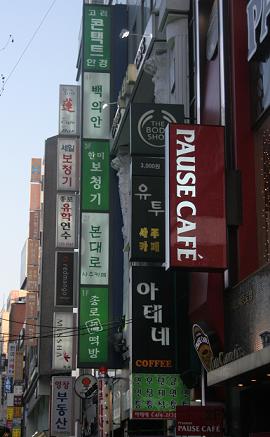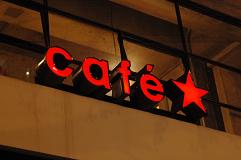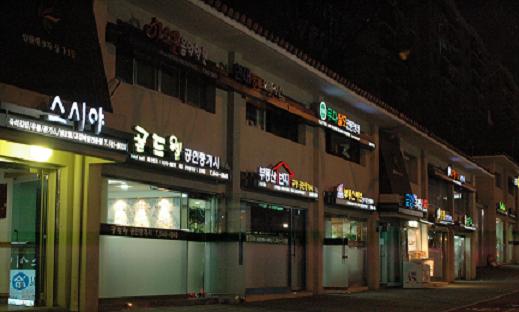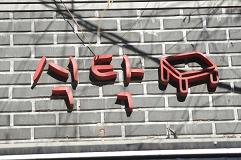The Culture of Korean signboards
WALKING DOWN Shinchon streets, you can see signboards everywhere. Turning your face over to the left, right or elsewhere, the signboards follow you. Exhausted and not wanting to see those dizzy signboards, you move away. However, just a one step away, there is another signboard. The phrase “too much is as bad as too little” comes to mind in this situation. This phenomenon is not only limited to Shinchon area. It happens everywhere you live. You may not recognize this phenomenon as “aestetic” pollution, but it surely is.
The role of signboards is to assist and inform people. However, expansion of undefined commercial sections and people’s selfishness brought the pollution of signboards. We, The Yonsei Annals, are not asserting that we have to get rid of these signboards. We need to realize the true purpose of signboards and improve their current conditions. Through the history of signboards, the Annals will investigate and discover the reasons for this phenomenon, as well as evaluate efforts necessary to establish a good signboard culture in Korea.
What are you signboard?
What really is a signboard? Let us reveal the true face hiding under its gorgeous decoration. According to the dictionary, a signboard is “a board bearing a notice sign(Britannica.” Although the main role of signboard is for the advertisement, one needs to mention its diverse aspects to define what a signboard is. First, in the aspect of advertisement, a signboard is a way of advertising that takes over some physical spaces. The basic characteristic of a signboard can be represented as symbolic, cognitive, limited to region, staying for long term, and informative. Second, from a legal aspect, a signboard is a “sign that can be temporarily seen in the place where the public passes by.” From the word “public,” we can realize the duality of a signboard. It is not only limited to an individual property, but is also a public good. A signboard belongs to a shop owner, but since the signboard is located outside the building, it is important to the public as well. In addition, the signboards are condensed texts of society. In case of Korea, the signboards reflect even the negative faces of Korean society, such as lack of creativity, sensitivity, and community awareness.
The origin of signboards
|
|
|
|
|
| ||
|
| ▲ The contrast of organized and disorganized signboards in Jongno-gu |
|
|
| ||
It took a long time for the current form of signboards to appear. In Joseon dynasty, there was a forefather of signboards called a “sign-curtain(po-ryum).” This curtain played the role of “public informative signs.” The current concept of signboards, used for the purpose of marketing, appeared in the late 1890s. Korea in 1894 had a political event called the Gabo Reform, which was to accept foreign facilities coming into Korea. The market business began to develop through this period and brought a new type of signboard using western style paints - a “painted signboard(ppang-gi ganpan).” In 1910, the new star called the “neon sign” originated and people were amazed by the gorgeous lights from the neon signs which brightened up the streets of Joseon. However, due to Japanese exploitation during the World War II and the effect of Korean War, there was nothing left to glow in the streets. In late 1950s, however, after those big wars, stores for professional signboard construction started to appear. In the 1960s, with President Park Chung-hee, the concept of signboard developed into outdoor advertising. Due to the radical economic growth which followed, the signboard became more diverse and numerous. Following this trend, recent signboards are getting bigger and more dazzling.
The current face of Korean signboards
The signboard culture in Korea has developed through time and we now have great skills in making signboards. However, the design of signboard established so far in Korea is in a relatively poor condition. The problems regarding signboards in Korea can be traced down into three aspects: size, color, and uniqueness. First of all, the signboards in the streets are too large without any particular purpose. “The formation of the big signboard came from a lack of artistic sense as well as a selfish mindset of the shop owners,” say Kim Young-bae (President of Environmental Design & Research Leading Kernel (EDRLK)). The desire of shop owners to make their signboard catch the sight of consumers brought about unnecessarily large signboards. Second, the colors of signboards are too stimulating. By using the primary color, the signboard might attract the eyes of people passing by. However, if all the signboards in one building are red, for example, it is not visually attracting. Moreover, considering the narrow surface of the signboard, using too many colors at once is not recommended; rather it could be confusing. Lastly, Korean signboards do not have their unique appearance. Signboards in Korea follows the standardized pattern of big board shaped with lights. Signboard is the face of a shop, thus it needs to contain the philosophy of the owner and have its unique feature, to remain in people’s memories.
The five must-have’s for a good signboard
1. The signboard in proper size
2. The signboard is in harmony
3. The signboard looking friendly
4. The signboard possessing uniqueness
5. The signboard with space
What is a good signboard?
Guidelines for good signboards
|
|
|
|
|
| ||
|
| ▲ It is simple and strong. The color of the signboard changes, but it does not have blinding lights around its body. |
|
|
| ||
Signboards play a great role in Korean public design. Many cities in Korea such as Busan and Anyang are trying hard to adjust their cities’ signboard culture. In this aspect, Seoul is in the center of an overall signboard improvement project. Seoul is in the leading group involved in improving the status of public design and has received the honor of World Design Capital (WDC). This is the result of Seoul Metropolitan Government (SMG)’s effort to make Seoul into a design city. As part of those projects, they are trying to establish guidelines related to the design of signboards. This will involve setting up a system that can be observed in “real world” situations. The laws and regulations related to the signboards so far differ from region to region. However, through these new systemized guidelines, signboards will be arranged neatly, and uniformly. “‘Variety in Unity and Unity in Variety’ is the answer for the signboard problem,” says Kwon Yong-gull (Deputy Mayor and Chief Officer of Seoul Metropolitan Government). By following this motto Seoul will surely have a new face, soon.
How can we participate?
Any effort that the government makes to improve the culture of signboards in Korea is important. However, without the help of citizens it is only a daydream. Citizens can be separated into shop owners and regular citizens; yet, they both need to cooperate in order to establish a good signboard culture. First of all, the shop owners need to change their thoughts and behavior as it relates to their signboards. Setting up big and fancy signboards is not the key to attract the passers. Shop owners need to adopt a new mindset that the signboards they own are not only their private properties but also a part of the overall public well-being. Furthermore, citizens have to pay attention to signboards. They need to realize that they are the “end consumers” of the signboards and thus are in charge of improving the current signboard culture. They need to view the overall appearance of their city with critical eyes.
To help these citizens, civil organizations such as The Bettersigns.org of The Hope Institute, were established. This organization researches the current status of signboards and tries to improve their condition as well as usage. The method used to improve our signboard culture employed by The Bettersigns.org is different from the other places. “Our signboard culture movement is using a positive approach,” says Choi Bum (Director of The Bettersigns.org, The Hope Institute). They are not trying to identify poorly utilized signboards. Instead, they try to show what a good signboard is, in order to educate people. Besides trying to define “what a good signboard is” in limited regulations, they are hoping for smooth natural changes adopted by citizens. There are several ways for citizens to participate. On the website of The Bettersigns.org, there is a section where people can share the photos of good signboards and their opinions about why those signboards are effective. In addition, citizens can vote to award a prize to good signboards. Through experiencing a good model of signboard and sharing opinions, people can contribute to bring about changes in Korean signboard culture. Also, citizens can support The Bettersigns.org by donating to this organization. These kind of citizens’ minor participation, are the key to improve our signboard culture.
|
|
|
|
|
| ||
|
| ▲ The well-harmonized signboards of Hyundai apartment arcade |
|
|
| ||
* * *
People have a desire to live in a comfortable and pleasant environment. They plant some trees in front of the houses to add some green to their “gray-dried” everyday life. Also, they plant flowers with a variety of colors, in order to decorate their environment. These small private attempts as well as paying attention to little details can bring about big improvements. The signboard is similar to these kinds of trees or flowers, which are desired for a better city view. Today’s Korean signboard culture is infringing upon our right to live in a beautiful city with a pleasant view and beautiful buildings. Citizens need to have a critical view toward neighborhood signboards and think about what constitutes a good signboard. Realizing the value of a signboard from now as well as trying to establish an image of good signboards, for the betterment of Korean society, is a task for all citizens. Establishing good signboards will help us walk our beautiful streets with happiness. Why not start today? One step leads to the next step!
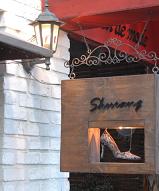
|
|
|
|
|
| ||
|
| ▲ This signboard has a picture of a “table,” which is the same as the name of the shop. Adding pictures on a signboard attracts the attention and gives fun to passers. |
|
|
| ||
|
|
|
|
|
| ||
|
| ▲ The fish picture and the Chinese letter in this signboard were written by the shop owner. It reflects or contains the owner’s life philosophy. |
|
|
| ||


